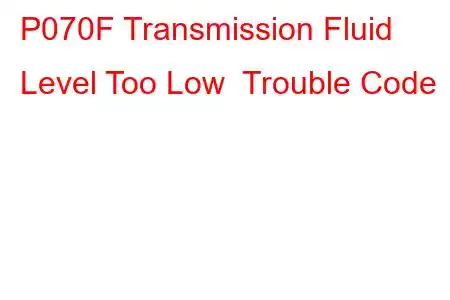P070F Transmission Fluid Level Too Low
OBD-II Trouble Code Technical Description
Transmission Fluid Level Too Low
What does that mean?
This generic powertrain diagnostic trouble code (DTC) typically applies to OBD-II equipped vehicles that have a transmission fluid level sensor. Makes of vehicles may include but are not limited to GM, Chevrolet, Ford, Dodge, Ram, Toyota, Hyundai, etc. This code is uncommon.
The transmission fluid level (TFL) sensor is used to illuminate a warning light on the dash in the case of low fluid level.
When the fluid level is within an acceptable range, the switch is grounded. When the transmission fluid drops below a predetermined level, the switch opens and a "low transmission fluid level" warning is displayed on the dash.
TFL sensors receive a reference voltage from the PCM. The PCM monitors the circuit and when it recognizes the switch has opened, it turns on the low fluid warning on the instrument cluster.
Code P070F is set when the PCM detects that the transmission fluid level is too low. Related codes include P070A, P070B, P070C, P070D, and P070E.
Code Severity & Symptoms
The severity of this transmission code is moderate to severe. In some cases, this and related codes can indicate a low transmission fluid level, that when left unattended to, can result in transmission damage. It's a good idea to address this code as soon as possible.
Symptoms of a P070F trouble code may include:
Illuminated low transmission fluid warning light Illuminated check engine light Transmission performance problemsCommon Causes Of This DTC Code
Possible causes for this code may include:
Faulty transmission fluid level sensor Low transmission fluid level (extremely likely) Wiring problems Faulty PCMDiagnostic and Repair Procedures
Begin by checking the transmission fluid level and condition in accordance with the manufacturer recommendations. Next, inspect the transmission fluid level sensor and the corresponding wiring. Look for loose connections, damaged wiring, etc. If damage is found, repair as necessary, clear the code and see if it returns. Next, check for technical service bulletins (TSBs) regarding the issue. If nothing is found, you will need to move forward to step by step diagnosis of the system.
The following is a generalized procedure, as testing for this code varies between vehicles. To accurately test the system, you'll want to refer to the manufacture's diagnostic flow chart.
Check The Wiring
Before proceeding, you'll want to consult the factory wiring diagrams to determine which wires are which. Autozone offers free online repair manuals for many vehicles and ALLDATA offers single vehicle subscriptions.
Check the reference voltage side of the circuit
With the ignition on, use a digital multimeter set to DC volts to check for reference voltage (usually 5 or 12 volts) from the PCM. To do this, connect the negative meter lead to ground and the positive meter lead to the sensor B+ terminal on harness side of the connector. If no reference signal is present, connect the meter set to ohms (with the ignition off) between the reference voltage pin on the TFL and the reference voltage pin on the PCM. If the meter reads out of limits (OL) there is an open circuit between the PCM and sensor that will need to be located and repaired. If the meter reads a numeric value, there is continuity.
If everything is good up to this point, you'll want to check that there is power coming out of the PCM. To do this, turn the ignition on and set the meter to DC volts. Connect the positive meter lead to the reference voltage terminal on the PCM and the negative lead to ground. If there is not a reference voltage from the PCM, the PCM is probably faulty. However, PCMs rarely go bad, so it's a good idea to double check your wor
Read: 31


